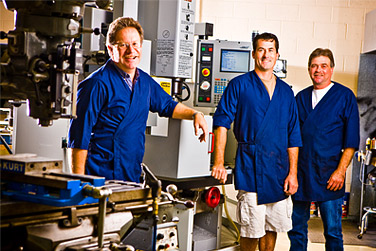News
Machine shop key to research efforts

From left: Tom Gruenauer, Kevin Cullinan and Gary Nottingham of the College of Arts and Sciences Instrument Machine Shop transform raw materials into devices that scientists can use in their experiments. Photo: DOUGLAS LEVERE
-
 Print
Print -
 Comments
(2)
Comments
(2)
-
“They’re really an essential part of the operation of any experimental department.”
Aluminum bars, copper tubes and Plexiglas rods crowd the stock racks of this workshop of wonders on the ground floor of Fronczak Hall, North Campus. Parts such as bolts, nails, nuts, screws and washers fill 360 shelves of a makeshift hardware cabinet—a series of wooden card catalogs discarded long ago by some university library. Machines populating adjacent rooms include belt sanders, saws, lathes, mills and welders. Thousands of tiny metal scraps shine in small piles on the floor, some shaped like pebbles and others curled like wisps of smoke.
This is the College of Arts and Sciences Instrument Machine Shop, where, for decades, university technicians have transformed raw materials into devices scientists use in experiments. Recent projects have included crafting Teflon cell growth chambers for a biological sciences professor and water flumes for faculty members studying such topics as the way sediments move in flowing water and landslides.
Kevin Cullinan, instructional support associate and one of the shop’s three full-time staffers, constructed a two-story-tall Foucault pendulum that is on view in Fronczak. Tom Gruenauer, instructional support specialist, is building a translation stage, an instrument designed to hold samples of materials researchers will examine inside a Dewar flask containing liquid helium at 4 degrees Kelvin.
“They’re really an essential part of the operation of any experimental department,” Francis Gasparini, chair of the Department of Physics, says of the instrument machine shop. “A lot of experiments in physics are designed from the bottom up, so often you need a piece of equipment that you cannot buy on the market.”
“They take great pride in their work,” he adds. “They will often come back into the lab and see the equipment they have built.”
Gruenauer, who is in his 20th year on the job at UB, says he and colleagues receive about 125 work orders annually, the vast majority of which come from researchers in the sciences. According to Gruenauer, while the state funds salaries for staff, the shop bills clients for services to cover expenses, such as supplies.
The shop, in its current iteration, was formed when separate facilities serving different departments within the College of Arts and Sciences merged. While Gruenauer does not know when the college established its first instrument machine shop, files he inherited from his predecessors suggest a long, rich history. One yellowed purchase order shows that in June of 1928, a faculty member spent $2,506 on a gear-headed lathe.
Cullinan, who started at UB seven years ago, is the junior member of the team. Gary Nottingham, an instructional support technician, just completed his 15th year on the job. Even after spending so much time at the university, all three shop workers say they continue to find their calling rewarding.
“I like the versatility. In industry, you’re handed a stack of prints and you build it,” Cullinan says. “Here, I’m more involved in the designing of everything I build.”
“I feel that I’m hopefully making a difference in the world because I’m helping (scientists) with their research,” Nottingham says. “Maybe they find a cure for some disease.”
“Every day is a challenge,” Gruenauer adds. “Every day is interesting.”
The job, after all, involves more than honing and utilizing technical skills. Designing gadgets for world-class researchers requires learning about science. The shop workers often get requests to build devices capable of operating in harsh environments—under a strong magnetic field, inside a chemical solution or in a cryogenics laboratory, for instance. Cullinan is working on a pair of coring apparatuses that one faculty member plans to use in Alaska and Greenland to recover sediment samples from lake bottoms.
UB faculty members receive wide recognition for their achievements, publishing in top-tier academic journals and giving interviews to the media about their discoveries. What many people on and off campus don’t know is that groundbreaking research often begins here, in this unassuming workshop where raw materials are fashioned into the instruments that make science possible.

Reader Comments
Christian Meining says:
Without these guys I wouldn't have graduated! I miss working with them.
Posted by Christian Meining, Ph.D., 07/09/09
John T Ho says:
Thank you for the excellent article. It is about time these unsung heroes receive their due recognition. Tom, Gary and Kevin are true professionals. They have played vital roles in not only the fabrication but the actual design of experiments that have led to important scientific discoveries in the CAS at UB.
Posted by John T Ho, SUNY Distinguished Service Professor of Physics, 07/02/09